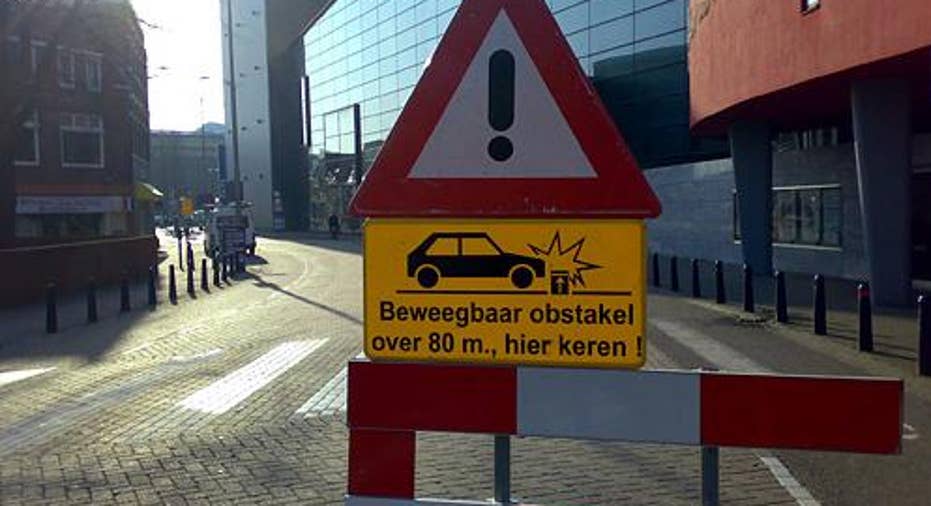The Five Biggest Obstacles Facing Driverless Cars

Image source:Michiel Jelijs.
I don't know about you, but I can't wait to take a nap in a car while sitting in the driver's seat. IHS Automotive thinks we won't see driverless car ubiquity until some time after 2050, though, so I'll probably be waiting for that siesta for quite a while.
There are a few things holding driverless cars back, despite technology companies and automakers working in an frenzy to make autonomous vehicles for the masses. Let's take a look at five of the obstacles below:
YouWhile it may seem that Americans love technology, we actually take a while to adopt new ideas. It took U.S. consumers more than eight years to hit a 10% adoption rate for smartphones. Now, think about how simple a smartphone is compared to a driverless car (which needs to keep you safe on the road). I don't know how long the adoption rate will be for self-driving cars, but it's very safe to say it'll be longer than smartphones.
Alphabet's Google wants its driverless cars to ride around without steering wheels, and that's likely going to be a major barrier for some people.People tend to feel just a tad uncomfortablegiving up control.
Additionally, researchers from the University of Michigan are already testing how well people respond to sitting in a driverless car, and it turns out we get pretty distracted. That'll be OK when the car is driving fine, but less so when we need to take over in an emergency.SecurityIf there's one major problem that could easily derail autonomous car progress it'll be security issues. The U.S. government pressured Fiat Chryslerto recall 1.4 millionvehicles after a very public security breach showed the controls of its Jeep Cherokee could be taken over wirelessly. And security will only become more important when more semi-autonomous and autonomous driving technology hits the market.
Mark R. Rosekind, the Administer of the National Highway Traffic Safety Administration (NHTSA) said last year that, "We must reassure vehicle owners that their data is secure, that their vehicle is secure, and that we are looking out for threats from hackers, thieves, and anyone else who might seek to tamper with safety-critical technology."
Vehicle responsibilityI think this is one of the more underreported problems of self-driving cars. Automakers are quick to say that they back their autonomous driving vehicles right now and take full responsibility for them; Volvo has probably been the most vocal about this. But as I've mentioned before,it's fairly easy for the company to take responsibility when zero autonomous cars have been sold to the public.
Fast forward a few years to when an autonomous car makes a wrong calculation and hits a pedestrian or causes a major pileup on the highway. I doubt automakers will be as keen to take full responsibility when something like that happens. We may see component makers, software creators, and automakers all pointing the finger at each other instead.
Laws Lots of progress is being made when it comes to driverless car laws. The Obama Administration recently pledged $4 billion over the next 10 years for autonomous car research. The money will help the U.S. government and tech companies to work together on the technology.
But there's still a lot to be figured out. California drafted legislation back in December saying that driverless cars need to have a driver behind the wheel at all times. Then this month, the National Highway Traffic Safety Administration (NHTSA) said that Google's artificial intelligence software is the driver in a driverless car.
The difference between what states allow and what the federal government says are anything but settled at this point. And that's going to keep some driverless tech in limbo for a while.
Weather Aside from all of the examples above, there's one very practical problem that could inhibit driverless cars: the weather.
As good as driverless car technology is right now, it still runs into problems in adverse weather conditions. Even rain is enough to throw some of Google's sensor technology off. Rain can impede the LIDAR sensors' ability to read road markings, which tell a driverless car where it is. Google is using other technology as a workaround, but it shows just how vulnerable some autonomous car tech can be.
None of these problems pose a longterm threat to driverless cars, but all of them will need to addressed (likely on an ongoing basis) before self-driving autos go mainstream.
The article The Five Biggest Obstacles Facing Driverless Cars originally appeared on Fool.com.
Suzanne Frey, an executive at Alphabet, is a member of The Motley Fool's board of directors. Chris Neiger has no position in any stocks mentioned. The Motley Fool owns shares of and recommends Alphabet (A shares) and Alphabet (C shares). Try any of our Foolish newsletter services free for 30 days. We Fools may not all hold the same opinions, but we all believe that considering a diverse range of insights makes us better investors. The Motley Fool has a disclosure policy.
Copyright 1995 - 2016 The Motley Fool, LLC. All rights reserved. The Motley Fool has a disclosure policy.